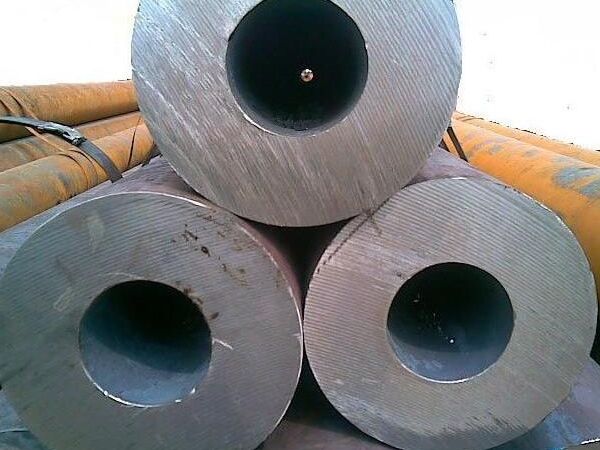Thick-walled carbon steel pipes are a type of carbon steel pipe with relatively large wall thickness, widely used in fields such as oil and gas transportation, high-temperature and high-pressure equipment, structural support, and industrial fluid transportation. It usually refers to a type of pipe where the wall thickness has a relatively large ratio to the nominal outer diameter, and the wall thickness exceeds the conventional series (such as API's XXS, ASTM's XH and XXH, etc.).
In the API 5L specification, thick-walled tubes can correspond to XXS (double thickening) or higher wall thickness specifications; In ASTM A106, Schedule 160, XS (Extra Strong) or larger grades can be selected; There is also a clear range of wall thickness for thick-walled pipes in EN 10210/10219. JIS G3454 stipulates that the WT can reach more than 30 mm. It can reach up to 140 mm at most in DIN EN 10210-1.

According to the production method, there are mainly two types of thick-walled seamless pipes:
Seamless thick-walled tubes: Produced by hot rolling, hot extrusion or hot cold drawing, they have no welds and possess excellent overall strength and pressure resistance.
Welded thick-walled pipes: including resistance welding, straight seam submerged arc welding, double-sided submerged arc welding, etc. The wall thickness standards of welded steel pipes are relatively flexible and can be adjusted flexibly, and are mostly suitable for large-diameter steel pipes.
Main chemical components
The chemical composition of thick-walled carbon steel pipes mainly consists of carbon, manganese, silicon, phosphorus and sulfur. Under different standards, the content of these elements also varies.
API 5L Grade B: C ≤ 0.30%, Mn ≤ 1.40%, P ≤ 0.025%, S ≤ 0.025%, Si ≤ 0.45%
ASTM A106 Grade B: C ≤ 0.30%, Mn 0.29-1.06%, P ≤ 0.035%, S ≤ 0.035%, Si ≥ 0.10%
EN 10210 S355J2H: C ≤ 0.20%, Mn ≤ 1.60%, P ≤ 0.025%, S ≤ 0.015%, Si ≤ 0.50%
Among them, some standards will also add trace amounts of elements such as Nb, V, and Ti to optimize the microstructure and welding performance.
Manufacturing process
API 5L (Pipeline Pipe)
Seamless: Diameter 2 "- 36", wall thickness can reach several inches.
ERW welding: Diameter 2 "- 24", wall thickness controlled by Schedule.
DSAW/LSAW: Diameter 20 "- 48", mostly used in large oil and gas pipelines.
ASTM A106/ASME SA106
Hot rolling: Produced by hot rolling with NPS ≥ 2 ", no heat treatment is required.
Cold drawing: NPS ≤ 1½ "can be cold-drawn and then annealed.
EN 10210-1 (Thermoformed thick-walled structured tubes) : Wall thickness 1-75 mm (light wall to thick wall), diameter 12-800 mm.
EN 10210 S355J2H: Wall thickness 1-40 mm, customizable length, and excellent pressure-bearing performance.
JIS G3454: It can be hot-rolled and cold-drawn, with a wall thickness of 1-30 mm and a diameter of 13.7-914.4 mm.
Mechanical performance
API 5L X46: Minimum yield strength 320 MPa, tensile strength ≥ 460 MPa.
EN 10210 S355J0H: Yield strength ≥ 355 MPa (16 mm wall thickness), tensile strength 510 MPa, elongation ≥ 22%.
ASTM A106 Grade B: Minimum yield strength 240 MPa, tensile strength ≥ 415 MPa, elongation ≥ 22%.
JIS G3454 STPG370: Yield strength ≥ 215 MPa, tensile strength ≥ 370 MPa, elongation ≥ 30%.
Due to the wall thickness effect, the strength and impact toughness of thick-walled pipes will slightly decrease as the wall thickness increases. This should be comprehensively considered when selecting materials.
Advantages
Excellent mechanical properties: The thicker pipe wall has higher elasticity and yield strength, making thick-walled pipes more suitable for high-pressure conditions.
High strength: Thick-walled pipes are less prone to deformation and can withstand greater mechanical pressure.
Pressure resistance: Due to its strong structure, thick-walled pipes can withstand higher internal pressure without failure.
In conclusion, thick-walled carbon steel pipes have a diverse international standard system in terms of chemical composition, manufacturing process and mechanical properties. According to specific working conditions and performance requirements, pipes under the appropriate API, ASTM, EN, JIS or DIN specifications can be selected to meet the needs of different engineering projects.
